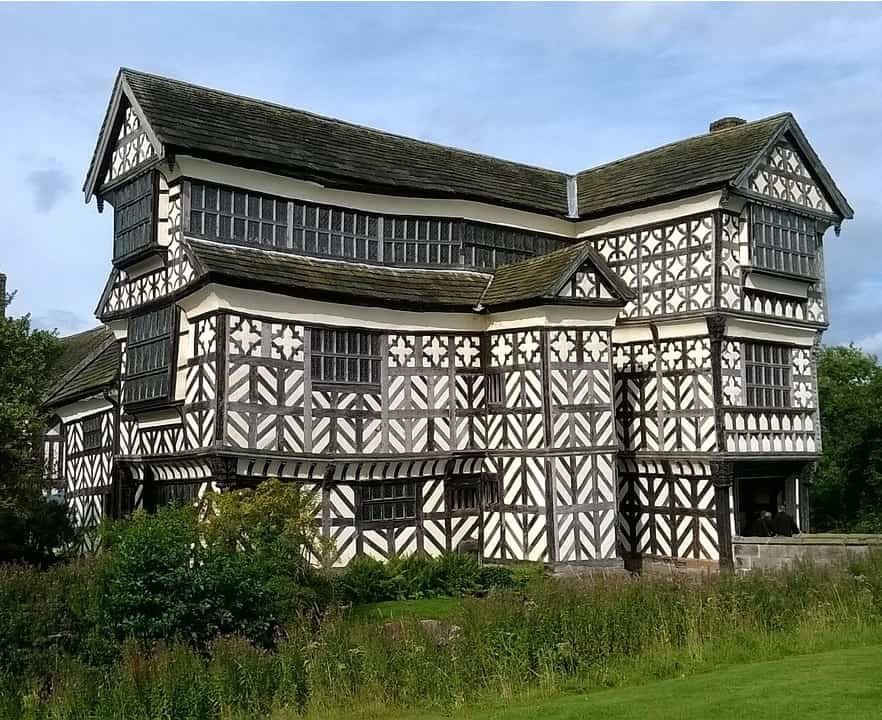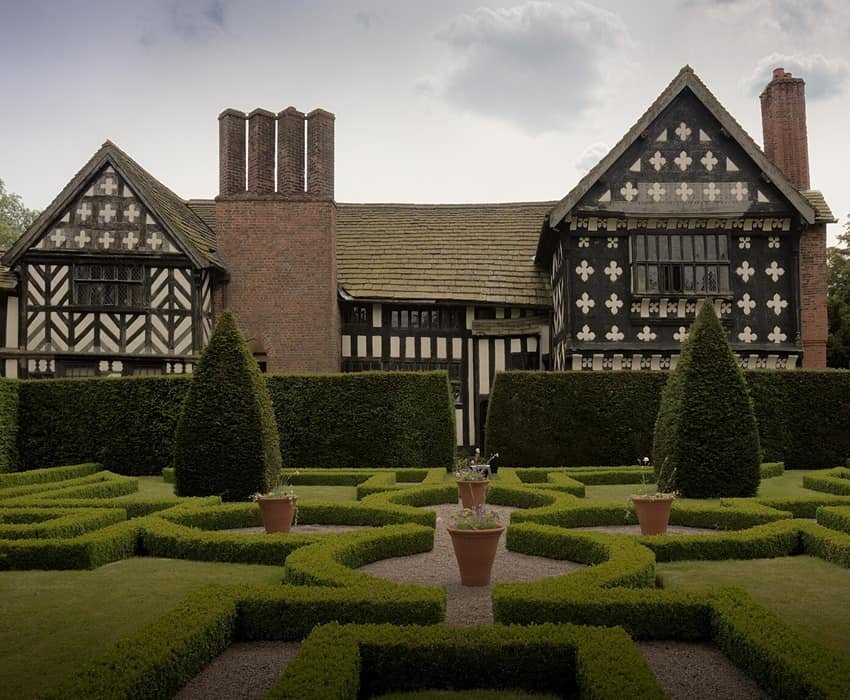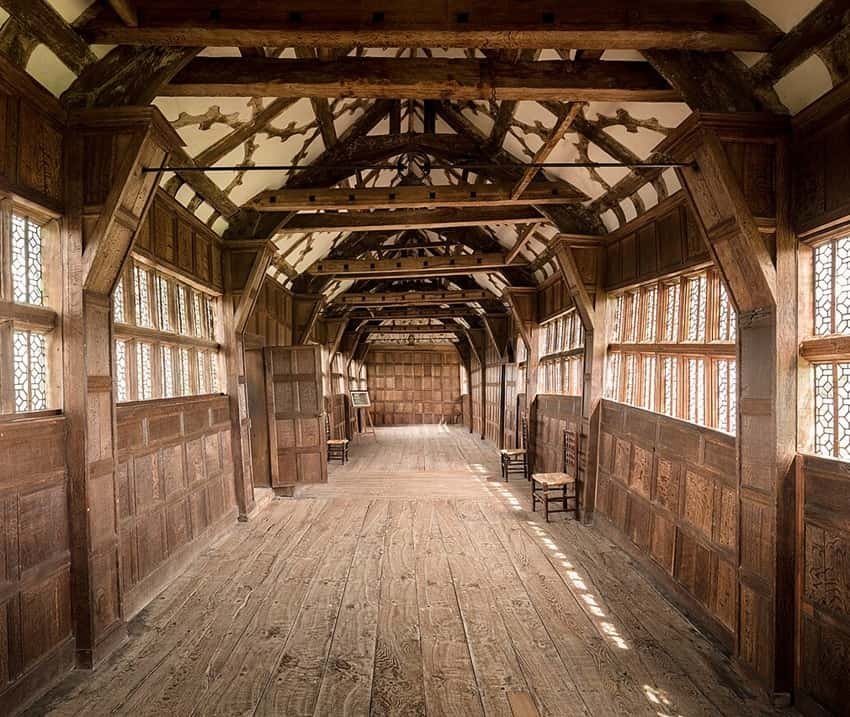Last Updated on 26th November 2025 by admin
Little Moreton Hall is a fantastic Tudor timber-framed manor house situated near Congleton in Cheshire, England. It is most famous for its medieval design, beautiful moated setting, and great architectural features. Constructed around the beginning of the 15th century, this historical treasure has managed to live through the turbulent period and now represents the well-preserved example of the Elizabethan art and family life.
It is a valuable heritage site with its timber frame, intricate panelling, towering gatehouse and unique twisted shape, which are all iconic and unique. The Hall gives a visitor a glimpse of the past by its preserved interiors, a long gallery and continued events reflecting its rich legacy.

Little Moreton Hall History
Little Moreton Hall goes back to the period of about 1271 although the actual construction of the present structure commenced in 1504 during the reign of William Moreton I. The building of the estate was carried out in phases and it occurred within a period of about a century until it was completed around the year 1600s. The Moreton family, wealthy landowners who gained prominence post-Black Death by acquiring extensive lands, constructed it as a display of status.
The Moreton family was on the Royalist side of the English Civil War, and in consequence, William Moreton III and his son Edward were put in prison. The property was seised and they rented it back to family members at a very high price hence making it a strain economically to them. The house was also rented by other tenants over the centuries, a factor that is ironical in maintaining its original features because of non-modernization. Eventually the house was given to the National Trust to preserve it.
Survival and Revival
Regardless of the political and economic turmoil, the existence of Little Moreton Hall speaks of the hard work of the caretakers and the National Trust. The deficit of modernization in its state when it was in the possession of tenants assisted in preserving a lot of the original Tudor features. The property was restored and preserved by the National Trust and is now open to the public and helps to revive it as a historic site.
The construction of timber structure, its unique warped floors and leaning walls are the reflection of centuries of erosion and habitation. The detail of the oak frame, leaded windows and carved patterns have been preserved to enable the visitors to feel the atmosphere of the owner of a Tudor manor house.
Design and Architecture

Little Moreton Hall is an ideal representation of late medieval and early Elizabethan timber-framed structure. It is an oak structure mounted on the footing of stone with ornate diagonal bracing in the shape of chevron and lozenge designs. The three ranges were constructed with time (north, east, and south) to create a rectangular courtyard with the south range containing a significant gatehouse.
The black and white timber framing of the house is further complemented by the 30,000 leaded glass panes that are geometrically laid in different patterns such as squares, lozenges and triangles. The front is highly adorned including the buttressing of the Flemish bond bricks and the highly carved wooden paneling. There is a moat around the house, 33 feet in width, which was rather a symbol of status, than a defensive measure.
The overhanging jetties of the ranges, concealed by beautiful coving, and the diaper patterns of the brick chimneys, all help to the aesthetic beauty of the hall. Materials used in the construction, oak wood available in the local woodlands, stone slabs available in Macclesfield, sand and lime available in Astbury, highlighting regional craftsmanship
Interior of Little Moreton Hall
The interior of Little Moreton Hall is a “corridor-less warren” of interconnected rooms and four staircases between different levels. The most ancient section of the house was the Great Hall which was a social centre with its wide arch-braced roof trusses and carved dragon decorations. The floor, once covered with rushes, has a central hearth for heating.
The parlour and the remaining withdrawing room have good wood panelling with painted biblical scenes, which depicts domestic decoration in Tudor style. The upstairs Long Gallery, which extends through the whole south wing, has its bowed floor of heavy stone roofing-slabs, and constant strips of window affording abundant light. This area was utilized to exercise and spend free time when the weather was bad.

There is not much original furniture, but in the Great Hall one may find such significant articles as a large refectory table and cupboards. The interiors reflect the Tudor life, with their uneven pavements, curved walls and period features like fireplaces with figures of Justice and Mercy, family shields and graffiti carved in the windows.
Also Explore: Famous tourist attractions in London
Little Moreton Hall Events
Little Moreton Hall has numerous events in the year that assist in bringing its old rooms and gardens to life. Past and recurring activities would be the Tudor themed story telling, traditional music performance, seasonal fairs, and festive Christmas celebrations like, “Deck the Hall”.
Visitors are able to attend spotter trails, archery adventure tours, craft classes, and historical reenactment. The hall is also open to Heritage Open Days and exhibits to help entertain both the families and history lovers. All these activities are designed to stimulate the spirit of the Tudor era and encourage the community to engage in the preservation of the heritage.
How to Visit Little Moreton Hall
The best approached by car since it is a rural place located near Congleton, Cheshire, about 25 miles south of Manchester. The property is operated by the National Trust and has a large car park on the premises. Little Moreton Hall opening times between 10:30 am to 5 pm and it closes on Mondays and Tuesdays during non school holidays.
The prices of admission differ depending on age, and members of the National Trust get in free. On-site tearooms are provided to serve seasonal products and a gift shop is located in the west wing. Visitors cross the legendary sandstone bridge over the moat to visit the hall, whereby there are guided tours and self-exploration. There are aspects of accessibility such as small doorways on historic buildings and asymmetrical floors, and mobility aids are allowed in particular spaces.
Summary
Little Moreton Hall is an interesting historic site of Tudor England featuring timber framing artistry, moat, and a close look into the experience of a wealthy gentry family. The hall provides a distinct cultural experience to the visitors through its elaborate architectural construction to its long historical process of surviving the rough history of England.
Little Moreton Hall still shows how much people can appreciate the rich heritage of England due to its careful preservation and interesting public events. It is the best place of historical treasure to visit in Cheshire, with its twisty walls and fascinating rooms to discover. It is a must-visit place to anyone who loves history or architecture.


